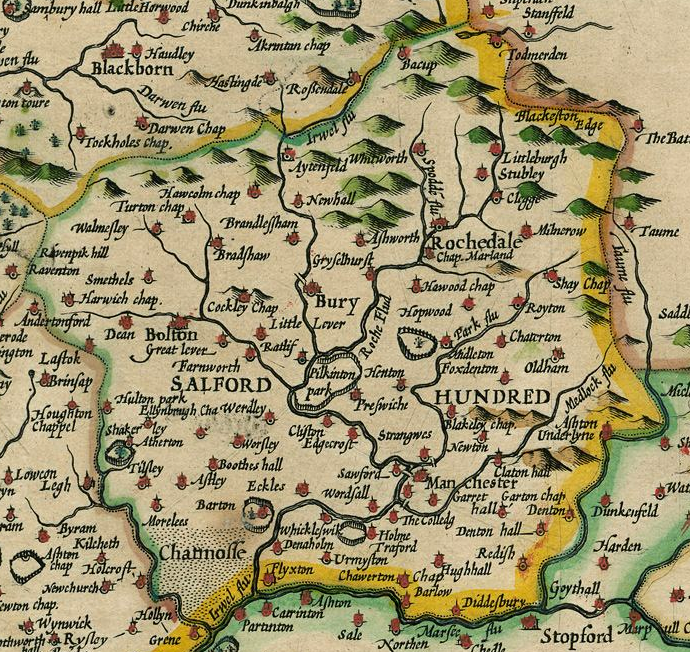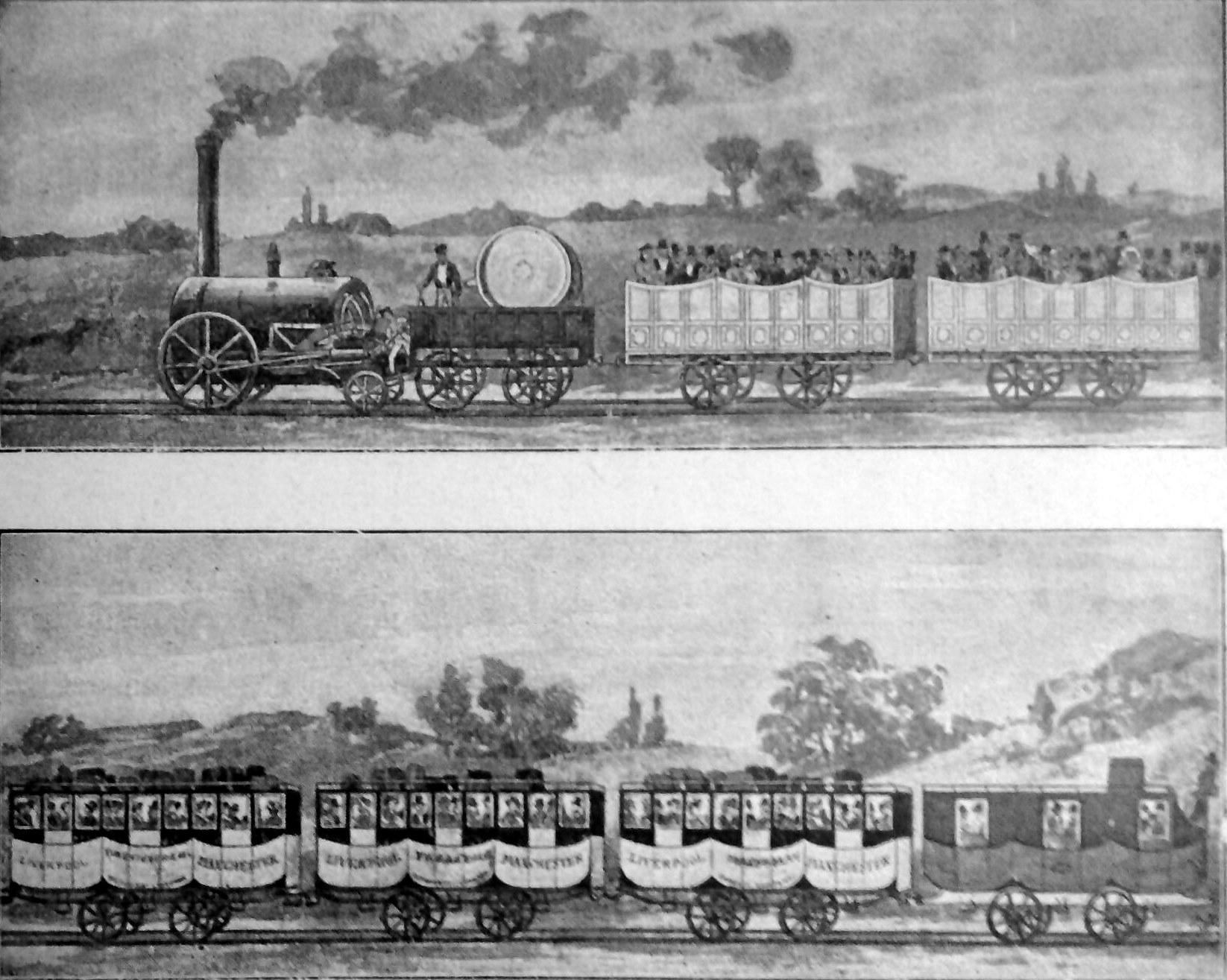|
Cross Lane Railway Station
Cross Lane railway station is a closed station on the Liverpool to Manchester line which was located on Cross Lane, Salford. It was one of the original stations on the Liverpool and Manchester Railway when it opened to traffic in September 1830, though initial facilities were very basic. It was later rebuilt by the L&MR's successor, the London and North Western Railway in more substantial fashion and by the end of the 19th century had platform faces on all four lines that passed through. British Railways closed the station to passenger traffic in July 1959 and to goods in January 1963."Disused Stations - Cross Lane" 'Disused Stations Site Record''; Retrieved 30 September 2016 It was subsequently demolished and no trace now remains – much of the former site is now occupied by the |
Salford, Greater Manchester
Salford ( ) is a City status in the United Kingdom, city in Greater Manchester, England, on the western bank of the River Irwell which forms its boundary with Manchester city centre. Landmarks include the former Salford Town Hall, town hall, Salford Cathedral, Salford Lads' Club and St Philip's Church, Salford, St Philip's Church. In 2021 it had a population of 129,794. The demonym for people from Salford is ''Salfordian''. Salford is the main settlement of the wider City of Salford metropolitan borough, which incorporates Eccles, Greater Manchester, Eccles, Pendlebury, Swinton, Greater Manchester, Swinton and Walkden. Salford was named in the Early Middle Ages, though evidence exists of settlement since Neolithic times. It was the seat of the large Hundred of Salford in the Historic counties of England, historic county of Lancashire and was granted a market charter in about 1230, which gave it primary cultural and commercial importance in the region.. It was eventually overt ... [...More Info...] [...Related Items...] OR: [Wikipedia] [Google] [Baidu] |
City Of Salford
The City of Salford is a metropolitan borough with City status in the United Kingdom, city status in Greater Manchester, England, named after its main settlement, Salford, which covers a larger area including Eccles, Greater Manchester, Eccles, Swinton, Greater Manchester, Swinton, Walkden and Pendlebury. The borough had a population of in , and is administered from the Salford Civic Centre in Swinton. Salford is the historic centre of the Salford Hundred an ancient subdivision of Lancashire. The City of Salford is the fifth-most populous district in Greater Manchester. The city's boundaries, set by the Local Government Act 1972, include five former local government districts. It is bounded on the southeast by the River Irwell, which forms part of its boundary with Manchester to the east, and by the Manchester Ship Canal to the south, which forms its boundary with Trafford. The metropolitan boroughs of Metropolitan Borough of Wigan, Wigan, Metropolitan Borough of Bolton, Bolto ... [...More Info...] [...Related Items...] OR: [Wikipedia] [Google] [Baidu] |
Ordnance Survey National Grid
The Ordnance Survey National Grid reference system (OSGB), also known as British National Grid (BNG), is a system of geographic grid references, distinct from latitude and longitude, whereby any location in Great Britain can be described in terms of its distance from the origin (0, 0), which lies to the west of the Isles of Scilly. The Ordnance Survey (OS) devised the national grid reference system, and it is heavily used in its survey data, and in maps based on those surveys, whether published by the Ordnance Survey or by commercial map producers. Grid references are also commonly quoted in other publications and data sources, such as guide books and government planning documents. A number of different systems exist that can provide grid references for locations within the British Isles: this article describes the system created solely for Great Britain and its outlying islands (including the Isle of Man). The Irish grid reference system is a similar system created by the ... [...More Info...] [...Related Items...] OR: [Wikipedia] [Google] [Baidu] |
Liverpool And Manchester Railway
The Liverpool and Manchester Railway (L&MR) was the first inter-city railway in the world. It Opening of the Liverpool and Manchester Railway, opened on 15 September 1830 between the Lancashire towns of Liverpool and Manchester in England. It was also the first railway to rely exclusively on locomotives driven by Steam engine, steam power, with no Horsecar, horse-drawn traffic permitted at any time; the first to be entirely double track throughout its length; the first to have a true Railway signalling, signalling system; the first to be fully Public transport timetable, timetabled; and the first to carry mail. Trains were hauled by company steam locomotives between the two towns, though private wagons and carriages were allowed. Cable railway, Cable haulage of freight trains was down the steeply-graded Wapping Tunnel to Liverpool Docks from Edge Hill junction. The railway was primarily built to provide faster transport of raw materials, finished goods, and passengers between ... [...More Info...] [...Related Items...] OR: [Wikipedia] [Google] [Baidu] |
London And North Western Railway
The London and North Western Railway (LNWR, L&NWR) was a British railway company between 1846 and 1922. In the late 19th century, the LNWR was the largest joint stock company in the world. Dubbed the "Premier Line", the LNWR's main line connected four of the largest cities in England; London, Birmingham, Manchester and Liverpool, and, through cooperation with their Scottish partners, the Caledonian Railway also connected Scotland's largest cities of Glasgow and Edinburgh. Today this route is known as the West Coast Main Line. The LNWR's network also extended into Wales and Yorkshire. In 1923, it became a constituent of the London, Midland and Scottish (LMS) railway, and, in 1948, the London Midland Region of British Railways. History The company was formed on 16 July 1846 by the ( 9 & 10 Vict. c. cciv), which authorised the amalgamation of the Grand Junction Railway, London and Birmingham Railway and the Manchester and Birmingham Railway. This move was prompted, in ... [...More Info...] [...Related Items...] OR: [Wikipedia] [Google] [Baidu] |
London, Midland And Scottish Railway
The London, Midland and Scottish Railway (LMSIt has been argued that the initials LMSR should be used to be consistent with London and North Eastern Railway, LNER, Great Western Railway, GWR and Southern Railway (UK), SR. The London, Midland and Scottish Railway's corporate image used LMS, and this is what is generally used in historical circles. The LMS occasionally also used the initials LM&SR. For consistency, this article uses the initials LMS.) was a British railway company. It was formed on 1 January 1923 under the Railways Act 1921, which required the grouping of over 120 separate railways into four. The companies merged into the LMS included the London and North Western Railway, the Midland Railway, the Lancashire and Yorkshire Railway (which had previously merged with the London and North Western Railway on 1 January 1922), several Scottish railway companies (including the Caledonian Railway), and numerous other, smaller ventures. Besides being the world's largest ... [...More Info...] [...Related Items...] OR: [Wikipedia] [Google] [Baidu] |
British Railways
British Railways (BR), which from 1965 traded as British Rail, was a state-owned company that operated most rail transport in Great Britain from 1948 to 1997. Originally a trading brand of the Railway Executive of the British Transport Commission, it became an independent statutory corporation in January 1963, when it was formally renamed the British Railways Board. British Railways was formed on 1 January 1948 as a result of the Transport Act 1947, which nationalisation, nationalised the Big Four (British railway companies), Big Four British railway companies along with some other (but not all) smaller railways. Profitability of the railways became a pressing concern during the 1950s, leading to multiple efforts to bolster performance, including some line closures. The History of rail transport in Great Britain 1948–1994#The Modernisation Plan, 1955 Modernisation Plan formally directed a process of dieselisation and Railway electrification in Great Britain, electrification ... [...More Info...] [...Related Items...] OR: [Wikipedia] [Google] [Baidu] |
M602 Motorway
The M602 motorway is a motorway, leading traffic into Salford, Greater Manchester, England, towards Manchester city centre and by-passing the town of Eccles. History The first section from Worsley to Eccles (now Junction 2) opened in 1971, and the second section from Eccles to Ordsall was completed in 1982. The motorway itself was originally intended to be a part of a bigger scheme, the South Lancashire Motorway. To be designated M52, the route would have linked Liverpool and Manchester, and would have been built to provide links to the growing UK motorway network. However, at the same time, the M62 was being extended north and east of Worsley, around the north of Manchester, and on to Yorkshire, to form part of the Trans-Pennine Motorway route. This would be an upgraded version of the original plan of the East Lancashire Road, the A580, but would link onto the existing route at Worsley. It was decided that the Trans-Pennine Motorway be extended to Liverpool too, to provi ... [...More Info...] [...Related Items...] OR: [Wikipedia] [Google] [Baidu] |
Liverpool Lime Street Railway Station
Liverpool Lime Street is a railway station complex located on Lime Street, Liverpool, Lime Street in Liverpool city centre. Although publicly a single, unified station, it is operationally divided into two official railway stations: Liverpool Lime Street High Level, the main station serving the city centre of Liverpool and the oldest still-operating grand terminus mainline station in the world; and Liverpool Lime Street Low Level, an underground Wirral line station (part of the List of underground stations of the Merseyrail network, Merseyrail network) connected to the main terminal building by a pedestrian subway below street-level. Despite their operational distinctions, both stations are integrated from a passenger perspective, sharing signage, access points and overall station identity. Lime Street High Level is one of 18 stations managed by Network Rail, while Lime Street Low Level is managed directly by the train operator, Merseyrail. A branch of the West Coast Mai ... [...More Info...] [...Related Items...] OR: [Wikipedia] [Google] [Baidu] |
Seedley Railway Station
Seedley railway station is a disused station located in the Seedley area of City of Salford, Salford, on the former Liverpool and Manchester Railway. The station was opened by the London and North Western Railway on 1 May 1882. It was located where Langworthy Road crossed the railway on an overbridge. The station building was at road level with a footbridge running parallel to the road and three sets of stairs going down to the three platforms. The platforms were all to the west of the road, there was a central platform with running lines on both sides and outer platforms with one face to the railway. The northernmost platform had a signal box located half way along it. The station had no goods facilities, only handling passengers and parcels, it closed on 2 January 1956. The line is still open. Parts of the station wall can still be seen but part of the trackbed has been covered over following the construction of the M602 motorway. __NOTOC__ References Citations Bibli ... [...More Info...] [...Related Items...] OR: [Wikipedia] [Google] [Baidu] |
Ordsall Lane Railway Station
Ordsall Lane railway station is a closed railway station on the Liverpool to Manchester line. History The station was located on the Liverpool and Manchester Railway, which opened to traffic in September 1830. The station wasn't listed in initial timetables, but early company records state that it was one of the intermediate stopping points on the route. By August 1849 it had been fully opened to traffic, though even then it wasn't listed in Bradshaw's Guide until March 1850."Disused Stations - Ordsall Lane" 'Disused Stations Site Record''; Retrieved 30 September 2016 One of its primary functions was to act as an interchange station between the L&MR (which from 1844 had been diverted to |






